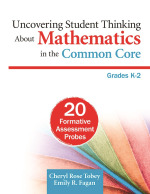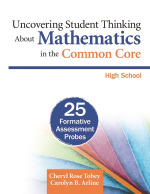These two wrap-up strategies from Bringing Math Students into the Formative Assessment Equation feature "reflect-aloud" and "X-marks-the-spot" to help students self-assess.
These two wrap-up strategies from Bringing Math Students into the Formative Assessment Equation feature "reflect-aloud" and "X-marks-the-spot" to help students self-assess.
Learn hands-on strategies for teaching geometry, measurement, and data excerpted from Planting the Seeds of Algebra 3-5. (Elementary)

Use this lesson from Uncovering Student Thinking About Mathematics in the Common Core, Grades K-2, to probe student understanding of addition and subtraction.
Using Audrey & Bruce Wood's book Ten Little Fish, students learn to count backward from 10 by 1s, a precursor for subtraction. This lesson appears in Numbers & Stories. (Elementary)
Students extend their understanding of place value by bundling tens with this lesson from The Common Core Mathematics Companion, K-2. (Elementary)
Students apply and extend previous understanding of multiplication and division to multiply and divide fractions using this lesson from The Common Core Mathematics Companion, 3-5. (Elementary)

Use this lesson from Uncovering Student Thinking About Mathematics in the Common Core, Grades 6-8, on linear equations to probe student understanding and misconceptions.

Use this lesson from Uncovering Student Thinking About Mathematics in the Common Core, High School, on equivalent expressions to probe student understanding and misconceptions.
Using this lesson from The Common Core Mathematics Companion, 6-8, students analyze proportional relationships and use them to solve real-world and mathematical problems (Secondary).
Learn how to design structured inquiry, guided inquiry, and open inquiry tasks on the topic of straight lines with this unit from Concept-Based Mathematics.
This excerpt from The Five Practices in Practice helps you assess student thinking in ways that take them from where they are now and move them towards the lesson goals.
This excerpt from The Five Practices in Practice demonstrates strategies to anticipate student responses in problem solving, including planning to respond to students using assessing and advancing questions, and preparing to notice key aspects of students’ thinking in the midst of instruction.